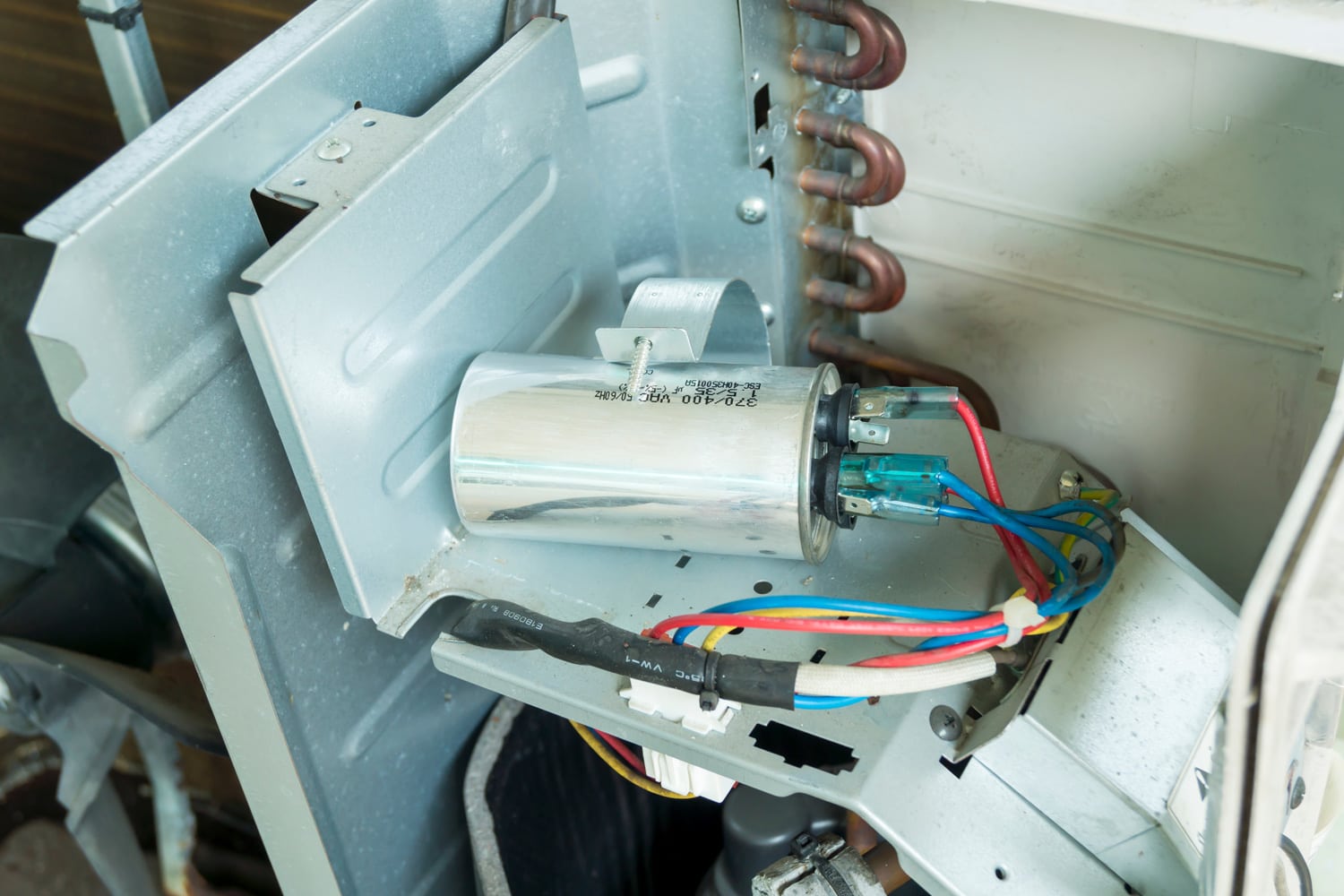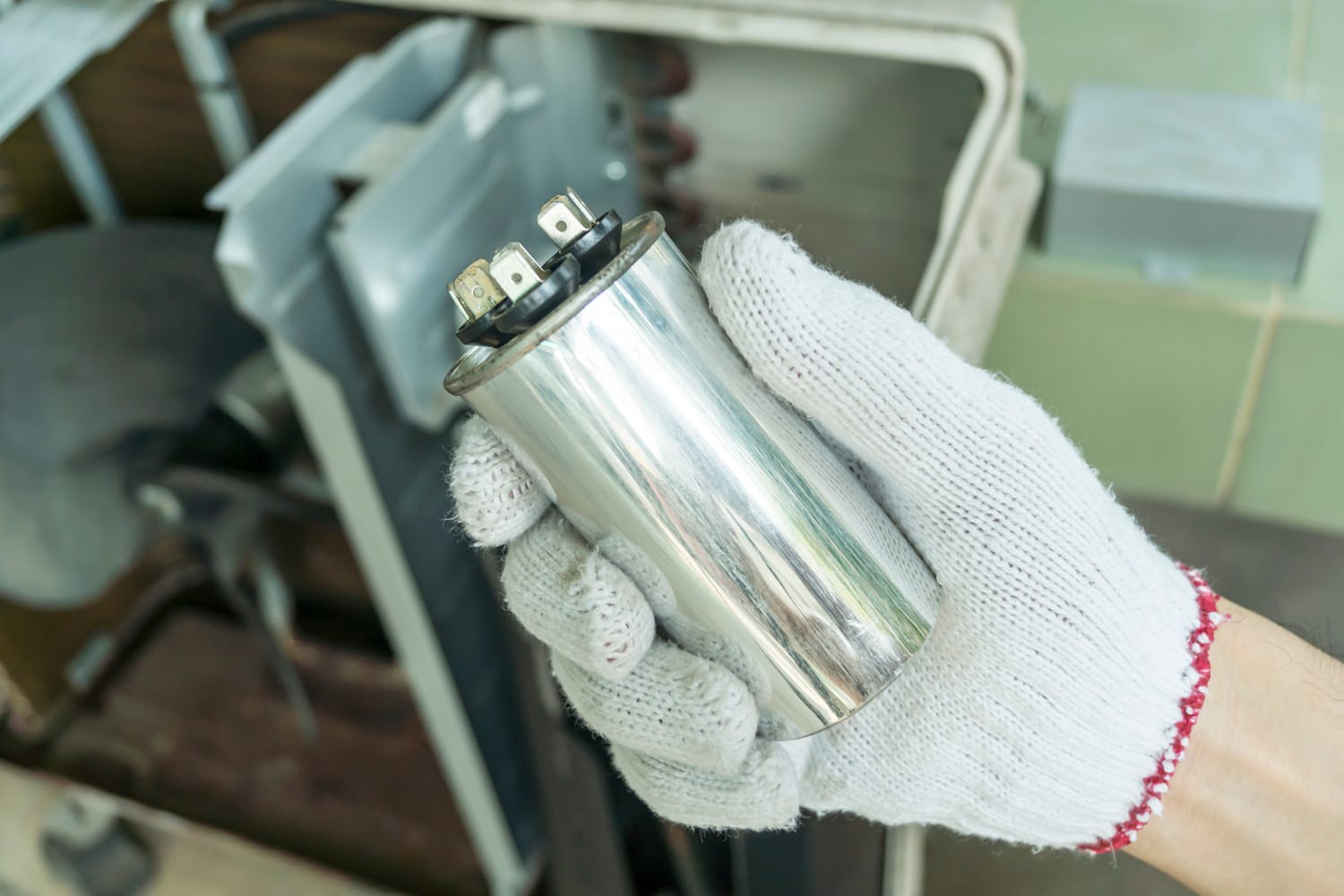In the electrical circuit of an air conditioning system, air conditioner capacitors are frequently employed. They serve varied functions in a variety of circuits. And if you're wondering about the number of capacitors in an air conditioning unit and where to find them, we researched that for you! Here is what we discovered.
Your air conditioner may use a variety of capacitors. But most units have four capacitors. You can find three run capacitors near the compressor, the outdoor fan motor, and the indoor fan motor. The fourth capacitor is the start capacitor.
Keep reading as we discuss how these capacitors function and why they're located near those components. We'll also cover the benefits of having capacitors in your AC unit, what causes them to go bad, and how much it costs to replace them.

How Do Air Conditioner Capacitors Function?
The initial surge of electricity your air conditioner's motors require to function properly is provided by an AC capacitor. It stores electricity and sends it to your system's motors in jolts that are strong enough to start the cooling cycle in your system.
The capacitor starts to produce less energy once your AC is operating, but it continues to provide a steady current of power until the cycle is complete.
How Are Capacitors Measured?

Microfarads and voltage are used to measure AC capacitors.
Voltage
The capacitor's voltage reveals how much electrical current is flowing through it. The electrical current flows through your capacitor more quickly, the higher voltage it has.
Microfarads
The capacitor's capacity for electrical current is measured in microfarads (μF). Most capacitors have an MFD (microfarads) range of 5 to 80.
Are Capacitors The Same As Batteries?
Due to its cylindrical shape and terminals on each end that is connected to an electrical circuit, the capacitor resembles a sizable battery. Batteries and AC capacitors operate in distinct ways, though.
An AC capacitor can store energy to keep the air conditioner motors at a constant charge, unlike batteries, which can only power a device.
Why Is A Capacitor An Important Piece Of Component In Your AC Unit?
Your air conditioning unit needs a stronger push to operate properly, even if it is connected to your home's electrical infrastructure. This is because air conditioners are powerful devices that demand a lot of energy to function as intended, and your home's wiring simply cannot supply enough electricity to perform the job.
The capacitor makes up for this by reactivating the motor of your cooling system and assisting it in cooling your house until it takes a little break. The capacitor resumes operation when another cooling cycle has finished.
Because of the crucial and demanding work that capacitors must perform, a failing capacitor is one of the most frequent causes of an air conditioner that won't work, especially in the summer.
What Are The Benefits Of Having Capacitors In Your AC Unit?
Here are two major benefits of having capacitors in your AC unit:
- Initial energy surge.
- Continuous electricity supply; prevents AC overheating or tripped breakers.
Why Do The Run Capacitors Located Near The Compressor And Fan Motors?

A run capacitor increases the current that powers the motor by making use of the charge in the dielectric. It is employed to keep a charge. Dual-run capacitors are seen in AC units. The fan motor is powered by one capacitor. The compressor receives power from the other.
What's The Difference Between Run And Start Capacitors?
Here are some characteristics of run and start capacitors to help you understand these types better:
Run Capacitors
- The run capacitor assumes control of an operational AC to provide the additional power needed to run the air conditioner for extended periods.
- These capacitors produce and store energy needed to shift to the next cycle.
- A dual capacitor system is frequently used in heat pumps and air conditioners to link the compressor and fan motors to the start and run capacitors.
- Run capacitors have a measurement range of 7-9 μF. The run capacitor must have an accurate value or rating. A value that is too high will result in an imperfect phase shift and an excessive winding current.
Start Capacitors
- When the motor starts, a start capacitor is present in the circuit of the start windings. Compared to a run capacitor, this capacitor has a higher capacitance.
- A start capacitor typically measures between 70 and 120 μF, though this might vary.
- The start capacitor gives the motor a quick electrical boost to start rotating. The motor would just hum when the voltage was applied without a start capacitor.
- The distinct start windings of the motor experience a current-to-voltage lag as a result of the start capacitor. The armature has a chance to start spinning with the field of current as the current progressively increases.
Can You Interchange A Run And Start Capacitor?

No, you can't. Run and start capacitors are two distinct types and can't be used interchangeably.
- A start capacitor often has a greater value (in μF) and is only intended to work for a relatively brief period when the motor is starting, therefore, it is unable to manage the power required continuously.
- A run capacitor is made for continuous use. When the motor is running, it is typically in the circuit and has a lower uF rating.
- Start capacitors are always single-section units, but run capacitors might include multiple-section units.
- The internal design of the two capacitors varies in both scenarios. Never attempt to substitute one for the other.
What Makes An AC Capacitor Faulty?
The capacitors in your air conditioning system ultimately wear out and require repair or replacement, just like any other component.
- Overheating is one of the main causes of a capacitor failing. Being quite heat-sensitive, the capacitor can easily overheat if the air conditioner is left in direct sunlight.
- The AC system may operate longer and harder than usual as the temperature rises, such as during a heat wave, which can also result in electrical overheating.
- The capacitors may potentially sustain permanent harm from power surges brought on by changes in the electrical grid or an overloaded circuit in your home.
- Another factor in capacitor failure is their age.
How Much Does It Cost To Repair An AC Unit Capacitor?
An AC capacitor typically costs around $170, ranging up to as much as $380 for brand-specific parts. Professional installation by a certified HVAC technician in generally between $75 and $200 per hour.
Homeowners should budget for the typical AC repair expense of replacing an AC capacitor. Fortunately, it's not too pricey. Prices will vary, though, depending on the sort of capacitor you require.
Should You Replace A Damaged Capacitor By Yourself?

Not at all. Although you can perform some AC maintenance tasks on your own, a qualified HVAC expert should replace your AC capacitor. The skilled specialist will know to correctly remove your failed capacitor and replace it with a new one, restoring your AC's proper operation.
Single Vs. Dual Run Capacitors: What Should You Choose?
One of the most crucial things to consider when comparing the many run capacitors available is whether the item is a single-unit run capacitor or a dual-run capacitor. Make sure the type of run capacitor you buy matches the one you are replacing when you replace the one in your unit.
Single Run Capacitors
Smaller HVAC systems, like small air conditioners, are more frequently utilized to connect a single motor to a single-unit run capacitor.
Click here for this product on Amazon!
Dual Capacitors
Two capacitors are combined into one with a dual-run capacitor. You may run two electric motors simultaneously with a dual-run capacitor. Dual-run capacitors are therefore perfect for bigger HVAC systems, such as air conditioners and heat pumps with both fan and compressor motors.
Click here for this product on Amazon!
In Summary
The compressor, outdoor fan motor, and indoor fan motor each have a capacitor to help them run continuously. Additionally, you can also find a start capacitor in your air conditioner.
These capacitors can either be single or dual. Make sure to replace your damaged capacitor with the right one.
Lastly, if you are having problems with your capacitors, it is best to call your trusted HVAC professional for help instead of dealing with it on your own.
Before you leave, you can check out these other related articles:
How To Buy The Correct AC Capacitor [Things You Need To Know!]


